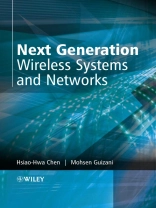Next Generation Wireless Systems and Networks offers an expert view of cutting edge Beyond 3rd Generation (B3G) wireless applications. This self-contained reference combines the basics of wireless communications, such as 3G wireless standards, spread spectrum and CDMA systems, with a more advanced level research-oriented approach to B3G communications, eliminating the need to refer to other material.
This book will provide readers with the most up-to-date technological developments in wireless communication systems/networks and introduces the major 3G standards, such as W-CDMA, CDMA2000 and TD-SCDMA. It also includes a focus on cognitive radio technology and 3GPP E-UTRA technology; areas which have not been well covered elsewhere.
- Covers many hot topics in the area of next generation wireless from the authors’ own research, including: Bluetooth, all-IP wireless networking, power-efficient and bandwidth-efficient air-link technologies, and multi-user signal processing in B3G wireless
- Clear, step-by-step progression throughout the book will provide the reader with a thorough grounding in the basic topics before moving on to more advanced material
- Addresses various important topics on wireless communication systems and networks that have emerged only very recently, such as Super-3G technology, 4G wireless, UWB, OFDMA and MIMO
- Includes a wealth of explanatory tables and illustrations
This essential reference will prove invaluable to senior undergraduate and postgraduate students, academics and researchers. It will also be of interest to telecommunications engineers wishing to further their knowledge in this field.
قائمة المحتويات
Preface.
About the Authors.
1. Introduction.
1.1 Part I: Background Knowledge.
1.2 Part II: 3GMobile Cellular Standards.
1.3 Part III: Wireless Networking.
1.4 Part IV: B3G and Emerging Wireless Technologies.
1.5 Suggestions in Using This Book.
2. Fundamentals of Wireless Communications.
2.1 Theory of Radio Communication Channels.
2.2 Spread Spectrum Techniques.
2.3 Multiple Access Technologies.
2.4 Multiple User Signal Processing.
2.5 OSI Reference Model.
2.6 Switching Techniques.
2.7 IP-Based Networking.
3. 3G Mobile Cellular Technologies.
3.1 CDMA2000.
3.2 WCDMA.
3.3 TD-SCDMA.
4. Wireless Data Networks.
4.1 IEEE 802.11 Standards for Wireless Networks.
4.2 IEEE 802.11a Supplement to 802.11 Standards.
4.3 IEEE 802.11 Security.
4.4 IEEE 802.15 WPAN Standards.
4.5 IEEE 802.16 WMAN Standards.
4.6 ETSI HIPERLAN and ETSI HIPERLAN/2 Standards.
4.7 MMAC by Japan.
4.8 Bluetooth Technologies.
5. All-IP Wireless Networking.
5.1 Some Notes on 1G/2G/3G/4G Terminology.
5.2 Mobile IP.
5.3 IPv6 versus IPv4 .
5.4 Mobile IPv6.
5.5 Wireless Application Protocol (WAP).
5.6 IP on Mobile Ad Hoc Networks.
5.7 All-IP Routing Protocols.
6. Architecture of B3G Wireless Systems.
6.1 Spectrum Allocation and Wireless Transmission Issues.
6.2 Integration of WMAN/WLAN/WPAN and Mobile Cellular.
6.3 High-Speed Data.
6.4 Multimode and Reconfigurable Platforms.
6.5 Ad hoc Mobile Networking.
6.6 Networking Plan Issues.
6.7 Satellite Systems in B3G Wireless.
6.8 Other Challenging Issues.
7. Multiple Access Technologies for B3G Wireless.
7.1 What B3GWireless Needs?.
7.2 A Feature Topic on B3GWireless.
7.3 Next-Generation CDMA Technologies.
7.4 Multicarrier CDMA Techniques.
7.5 OFDMTechniques.
7.6 Ultra-Wideband Technologies.
8. MIMO Systems.
8.1 SIMO, MISO, and MIMO Systems.
8.2 Spacial Diversity in MIMO Systems.
8.3 Spacial Multiplexing in MIMO Systems.
8.4 STBC-CDMA Systems.
8.5 Generic STBC-CDMA System Model.
8.6 Unitary Codes Based STBC-CDMA System.
8.7 Complementary Coded STBC-CDMA System.
8.8 Discussion and Summary.
9. Cognitive Radio Technology.
9.1 Why Cognitive Radio?.
9.2 History of Cognitive Radio.
9.3 What is Cognitive Radio?.
9.4 From SDR to Cognitive Radio.
9.5 Cognitive Radio for WPANs.
9.6 Cognitive Radio for WLANs.
9.7 Cognitive Radio for WMANs.
9.8 Cognitive Radio for WWANs.
9.9 Cognitive Radio for WRANs: IEEE 802.22.
9.10 Challenges to Implement Cognitive Radio.
9.11 Cognitive Radio Products and Applications.
10. E-UTRAN: 3GPP’s Evolutional Path to 4G.
10.1 3GPP TSG for E-UTRAN.
10.2 Origin of E-UTRAN.
10.3 General Features of E-UTRAN.
10.4 E-UTRAN Study Items.
10.5 E-UTRAN TSGWork Plan.
10.6 E-UTRAN Radio Interface Protocols.
10.7 E-UTRAN Physical Layer Aspects.
10.8 Summary.
A: Orthogonal Complementary Codes (PG = 8 ∼ 512).
B: MAI in Asynchronous Flat Fading UWB Channel.
C: MI in Asynchronous Modified S-V UWB Channel.
D: Proof of Equation (8.44).
E: Properties of Orthogonal Complementary Codes.
F: Proof of Equation (8.66).
Bibliography.
Index.
عن المؤلف
Professor Hsiao-Hwa Chen is the Director of the Institute of Communications Engineering at the National Sun Yat-Sen University, Tawian.
Professor Mohsen Guizani is currently an Associate Professor at the Electrical and Computer Engineering department of the University of Missouri-Columbia. Prior to joining the University, he was with the Faculty of Computer Engineering Department at the University of Petroleum and Minerals, Saudi Arabia. His research interests include Computer Networks, Optical Interconnection Networks for Massively Parallel Computers, Design and Analysis of high-speed network protocols, performance evaluation of computer systems, and wireless communications and networking. He served as a guest editor in the International Journal of Computer Systems and Networks, special issue on ‘ATM Switching/Networking Architectures and Performance’, a guest editor of a special issue in the INFORMATICA Journal on ‘Design Issues of Gigabit Networking’, and a guest editor of a special issue of the International Journal of Communication Systems on ‘Wireless Local Loops and Wireless ATM Networks’.












